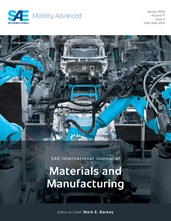The impact of texture on r-value and its measurement in magnesium alloy sheets has been studied using digital image correlation and electron backscatter diffraction techniques. Two magnesium alloy sheets with distinct textures were used in the present study, namely, AZ31 with a strong basal texture and ZE21 with a randomized texture.
It is well known that a conventionally processed AZ31 magnesium sheet has strong basal texture, necessitating contraction and double twinning to accommodate thinning strain. The strain distribution on the sheet surface evolves nonlinearly with strain, impacting the measured r-value. In particular, the normal approach to measuring r-value based on average strains over the gauge section leads to the erroneous conclusion that r-value increases with deformation. When the r-value is measured locally at any point inside or outside the neck, the r-value is shown to have a constant value of 3 for all strain values. In contrast, in ZE21 magnesium alloy sheet containing 2 wt.% zinc and 1 wt.% cerium, a random texture can be obtained using an annealing schedule reaching full recrystallization of the material. This material exhibits more uniform deformation and much longer tensile elongation. There is then no discrepancy between the r-value measured locally and globally and the r-value is close to 1.
